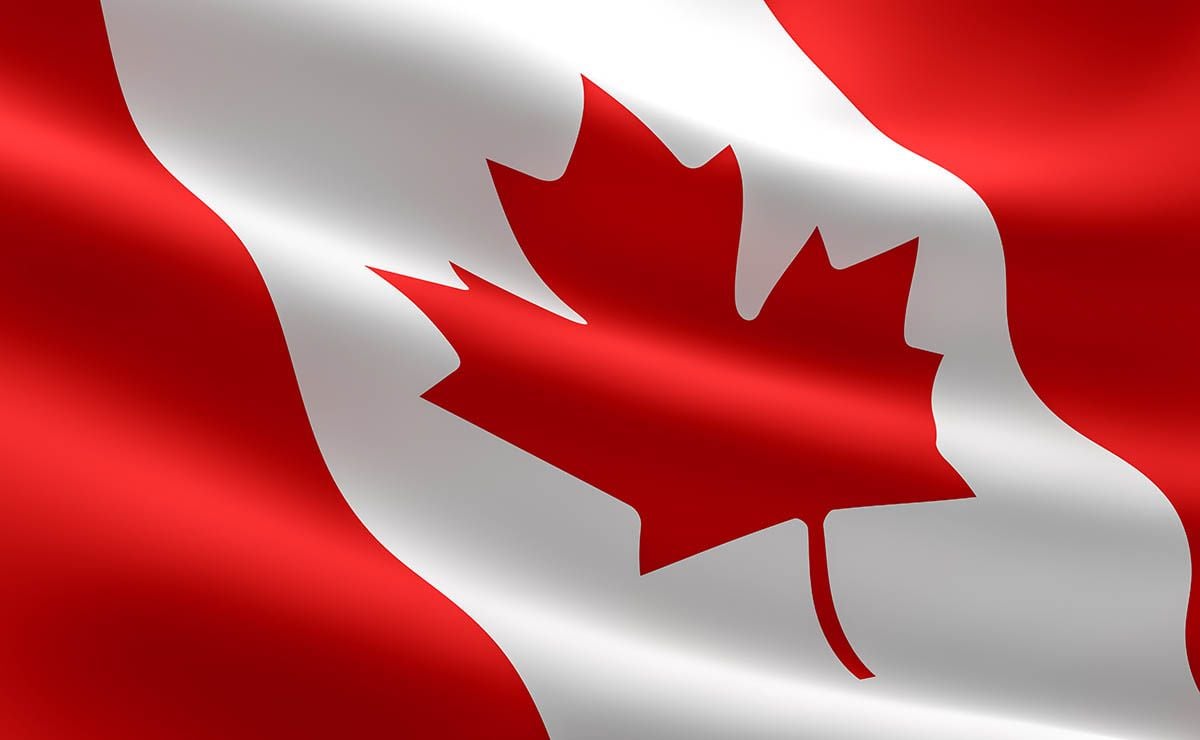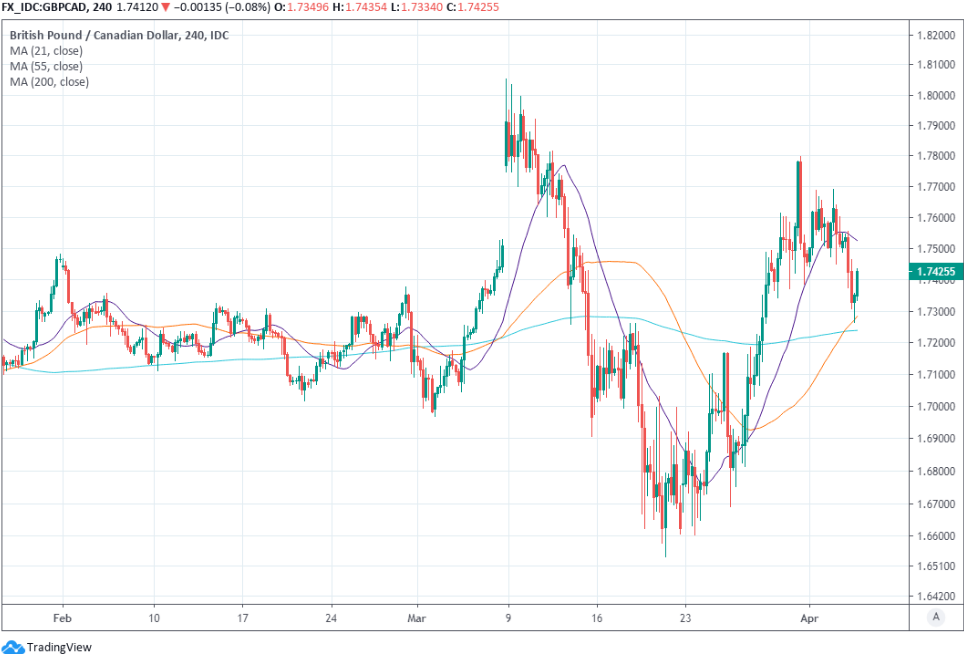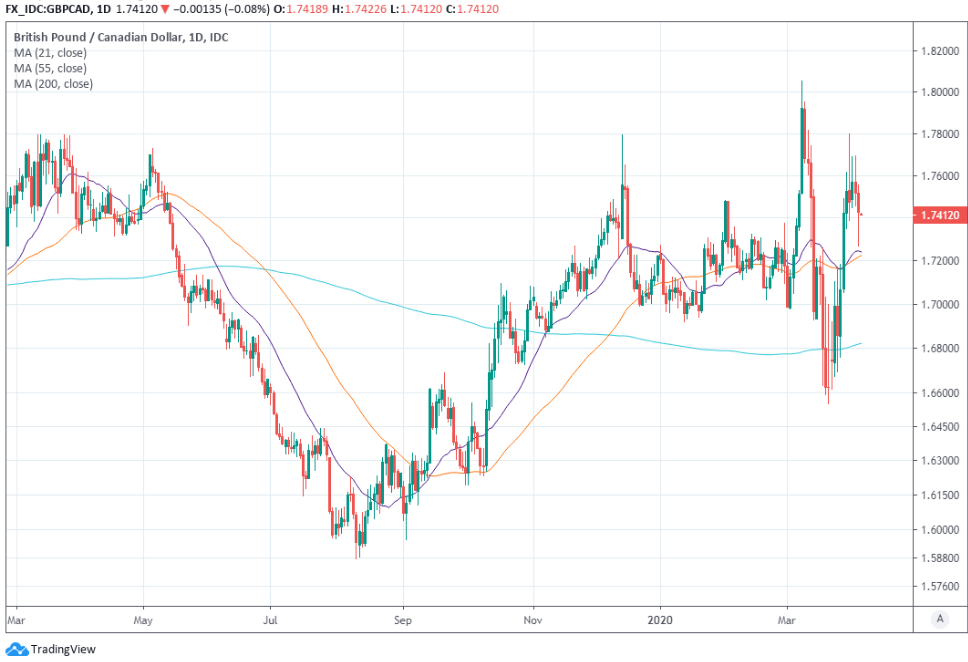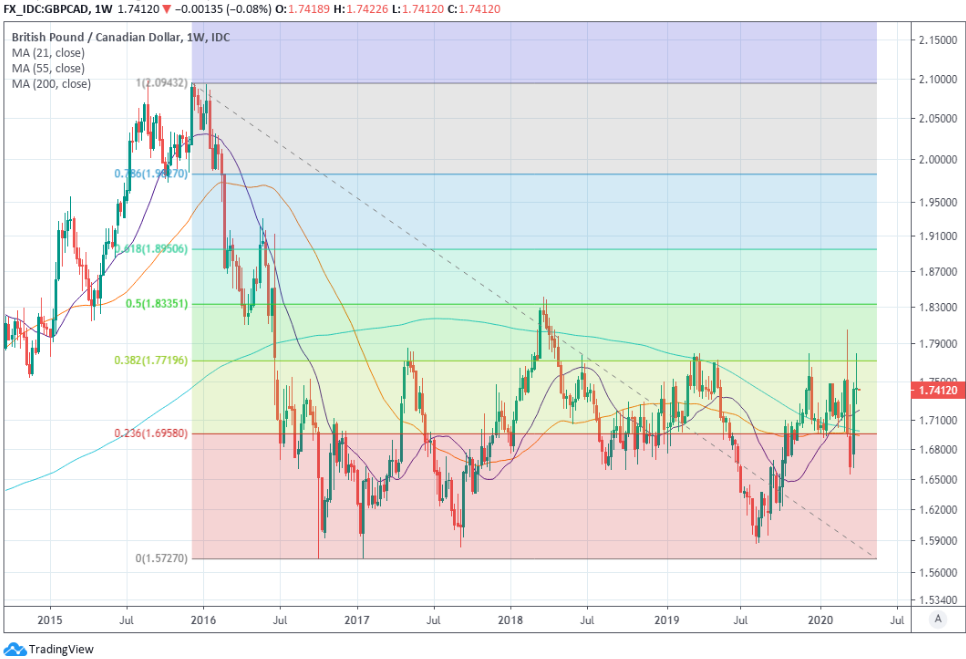Pound-Canadian Dollar Rate Week Ahead: Eyes On 1.68 as Loonie Cheers Oil Recovery, Virus Slowdown
- Written by: James Skinner
- GBP/CAD ends week on soft footing and risks declines ahead.
- After 1.78 resistance blocks GBP/CAD path higher once again.
- Oil prices, OPEC and coronavirus slowdown all bullish for CAD.
- More so than for GBP, pointing GBP/CAD lower and risking 1.68.

Image © Adobe Stock
- GBP/CAD spot at time of writing: 1.7547
- Bank transfer rates (indicative): 1.6846-1.6968
- FX specialist rates (indicative): 1.7195-1.7300 >> Get your quote now
The Pound-Canadian Dollar rate ended last week with only a fractional loss but the going could very easily get a lot tougher for this British exchange rate over the coming days, with technical and fundamental factors conspiring to push it lower and potentially as far as the 1.68 handle.
Sterling traded sideways in a 300 point range against the Canadian Dollar through much of last week before a last minute buckling of the legs took the Pound-Canadian Dollar rate down through the 1.74 handle in early Friday trade only for the exchange rate to find support near a cluster of moving averages between 1.72 and 1.7250. That price action came as the Loonie benefited from an ongoing recovery of oil prices, although the exchange rate was left unchanged for the week.
The Pound-Canadian Dollar rate pared losses between the latter par of the European session and all the way into the North American close Friday after the March non-farm payrolls report showed coronavirus eating away at the U.S. job gains of recent years. In just one single month the virus eliminated nearly all the new jobs created during the Trump presidency, spooking investors and stoking demand for the again-safe-haven greenback.
However, investors will return to their desks Monday with Saudi Arabia having delayed the pricing announcement for oil it produces in the hope that a production-reduction agreement can be struck between Organization for Oil Exporting Countries (OPEC) and others. And they will also awake to confirmation of a broad slowdown in the spread of coronavirus across the U.S. and Europe. Taken together this could produce a more favourable backdrop for the oil and risk-sensitive Canadian Dollar than it does Sterling.
"The CAD is ending a tough week on the defensive, down 1% versus the USD, reflecting febrile risk sentiment as the economic impact of the COVID-19 pandemic reveals itself more fully in the data. If we could pinpoint a fundamental reason for the CAD’s relative softness, it might be that Canadian employment trends appear to have been hit somewhat harder by the halt to all but essential economic activity," says Shaun Osborne, chief FX strategist at Scotiabank.
Above: Pound-Canadian Dollar rate shown at 4-hour intervals, cushioned by moving-averages on Friday.
The ongoing and likely-continued recovery in the oil market is good news for the commodity-backed Canadian economy and Dollar, and more so after the FT reported over the weekend that Canada and the U.S. are considering placing tariffs on Saudi and Russian oil which might effectively nullify or neutralise in the U.S. and Canada the cartel's recent failure to 'stabilise the market.' Tariffs would impose a higher price on consumers for gasoline at the pump in the U.S. and Canad but they would also protect the oil sector jobs, GDP and tax revenues that would surely be at risk if the Saudi-Russia price war goes on.
For leaders of western democracies who've gone hurtling down a rabbit hole that has already has lots of 'Chinese characteristics, tariffs would be as efffective but less politically incendiary than engaging directly in cartel-like management of what's meant to be a market. What matters most for the Canadian currency though, with coronavirus aside, is that the oil price not only sustains last week's gains but also goes on rising. There's a good chance that it will do, in the U.S. and Canada at least, and the only thing that remains to be determined is if those price increases come through tariffs or an OPEC+ agreement.
"Distortions aside, though, the number of tests continues to rise, and the proportion of positive tests is beginning to fall," says Ian Shepherdson, chief economist at Pantheon Macroeconomics, referring to the number of new coronavirus cases confirmed in the U.S. "Case growth continues to slow in continental western Europe...Elsewhere, Spain, Germany, the Netherlands and Austria all reported the lowest daily increases since the crisis began."
The latest developments in the oil price saga are even more bearish for the Pound-to-Canadian Dollar rate when considering that they will be acknowledged by investors at the same time as those money managers digest a broad slowdown in the spread of coronavirus across the U.S. and Europe. Currently what matters most for exchange rates is the relative spread of coronavirus between countries as well as the difference in actions taken to put a lid on it, although if the recent ebb of the spread is sustained over the course of the coming days then it might not be long before the staggered lifting of so-called 'lockdowns' slips into the driving seat.
Above: Pound-Canadian Dollar rate shown at daily intervals, cushioned by moving-averages on Friday but vulnerable.
Canada's Dollar has a higher 'beta' to investors' appetite for risk so in times when oil prices are rallying and the mood in the market is brightening, as could well happen in the week ahead, the Loonie can normally be expected to prevail over Sterling. This outlook is burnished by developments on the charts like the daily one above, which shows Sterling failing again last week to crack the 1.78 handle that prompted a series of declines that may only have been temporarily 21 and 55-day moving-averages.
Sterling has been below those short-term averages on a number of occasions of late and could easily fall back beneath them again if a 'risk-on' does ultimately materialise and govern trading this week. And once below there the tried, tested and once-broken support at 1.70 is the only thing standing between the British currency and the 200-day moving average located 200 points south of even the 1.70 level. Breaking below here could have bearish long-term implications.
This and the coming weeks could be important for Sterling in terms of its long-term trend against the Canadian Dollar as the exchange rate is at both a technical and fundamental inflection point. March volatility brought bullish developments on the long-term charts which have since been unwound and price action this week could see investors refocus their attention on the low point of the 1.57-1.84 post-Brexit-referendum range for the exchange rate.
"The pound’s rebound from the 1.69 zone looks a little more compelling, however, as it maintains strength into month end and trend momentum signals on the shorter-term studies start to dovetail again with the still bullishly-oriented longer term trend strength (DMI) oscillators," says Juan Manuel Herrera, a Scotiabank strategist, in a March 30 technical briefing. "We think the 1.78/1.80 zone remains major, long-term resistance for the GBP and there is significant, long term resistance above here at 1.84 (early 2018 high and potential 1.58 double bottom trigger)."
Above: Pound-Canadian Dollar rate shown at weekly intervals.







